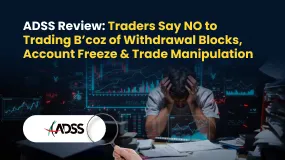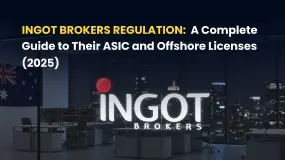简体中文
繁體中文
English
Pусский
日本語
ภาษาไทย
Tiếng Việt
Bahasa Indonesia
Español
हिन्दी
Filippiiniläinen
Français
Deutsch
Português
Türkçe
한국어
العربية
OspreyFX's Sudden Shift from MT4/MT5 to TradeLocker Stirs Discontent
Abstract:OspreyFX sparked controversy by making a bold move this week: opting to replace the well-established MetaTrader 4 and 5 (MT4/MT5) with its in-house platform, TradeLocker. Despite being marketed as an advanced trading experience, this transition has triggered a wave of complaints from users, casting doubt on the broker's future and signalling potential concerns.

OspreyFX sparked controversy by making a bold move this week: opting to replace the well-established MetaTrader 4 and 5 (MT4/MT5) with its in-house platform, TradeLocker. Despite being marketed as an advanced trading experience, this transition has triggered a wave of complaints from users, casting doubt on the broker's future and signalling potential concerns.




While OspreyFX emphasizes TradeLocker's speed, mobile-centric design, and social trading components, abruptly disconnecting from a platform used by millions worldwide seems disruptive.
The TradeLocker shift raises concerns on a broader scale, for several reasons:
- Eroding Trust and User Confidence:
MT4/MT5 are industry standards used by millions globally. Moving away from such established platforms raises doubts about the broker's commitment to user needs and best practices.
Abrupt platform changes without comprehensive support and user buy-in can significantly erode trust in the broker, leading to customer churn and reputational damage.
- Functionality and Familiarity Concerns:
MT4/MT5 offer extensive customization options, technical indicators, charting tools, and automated trading capabilities, features deeply ingrained in traders' workflows. A less established platform like TradeLocker may lack these functionalities, frustrating experienced users and hindering their trading experience.
Learning a new platform takes time and effort, especially for complex financial instruments. Forcing users to adapt to a less familiar platform disrupts their trading routines and could lead to costly mistakes.
- Compatibility and Data Migration Issues:
Integration with industry tools, data providers, and third-party services built around MT4/MT5 might not be smooth with TradeLocker, potentially limiting users' trading options and access to valuable data.
Concerns arise about seamless data migration from MT4/MT5 to TradeLocker. Historical data and open positions are crucial for traders, and any hiccups in the transition could lead to financial losses.
- Lack of Transparency and Motive:
The rationale behind abandoning widely adopted platforms for a proprietary one often remains unclear. This lack of transparency breeds suspicion and raises questions about the broker's priorities and potential cost-cutting measures over user needs.
Users might doubt the true value proposition of the new platform and suspect hidden agendas that prioritize the broker's interests over theirs.
- Uncertainty and Potential Market Instability:
A mass exodus of users due to dissatisfaction with TradeLocker could damage the broker's reputation and market share.
Uncertainty surrounding the platform's stability and future development could further erode trust and destabilize the broker's position in the competitive forex market. The core of dissatisfaction revolves around perceived shortcomings in TradeLocker. Users lament its cumbersome interface, limited features compared to the extensive customization options in MT4/MT5, and the unfamiliarity of the platform.




While OspreyFX's gamble on TradeLocker may pay off eventually, the current backlash from users and lingering uncertainties paint a worrying picture.
It is important to note that Osprey FX, which lacks a regulatory license, holds a low rating from WikiFX. This absence of regulation indicates potential heightened risk within its operations.


As a precaution, WikiFX strongly advises users to consider brokers with a minimum WikiFX score of 7.0, ensuring regulation and stability. Prioritizing safety over uncertainty remains paramount in broker selection.

Disclaimer:
The views in this article only represent the author's personal views, and do not constitute investment advice on this platform. This platform does not guarantee the accuracy, completeness and timeliness of the information in the article, and will not be liable for any loss caused by the use of or reliance on the information in the article.
Read more

Grand Capital Doesn’t Feel GRAND for Traders with Withdrawal Denials & Long Processing Times
The trading environment does not seem that rosy for traders at Grand Capital, a Seychelles-based forex broker. Traders’ requests for withdrawals are alleged to be in the review process for months, making them frustrated and helpless. Despite meeting the guidelines, traders find it hard to withdraw funds, as suggested by their complaints online. What’s also troubling traders are long processing times concerning Grand Capital withdrawals. In this Grand Capital review segment, we have shared some complaints for you to look at. Read on!

EmiraX Markets Withdrawal Issues Exposed
EmiraX Markets Review reveals unregulated status, fake license claims, and withdrawal issues. Stay safe and avoid this broker.

ADSS Review: Traders Say NO to Trading B’coz of Withdrawal Blocks, Account Freeze & Trade Issues
Does ADSS give you plenty of excuses to deny you access to withdrawals? Is your withdrawal request pending for months or years? Do you witness account freezes from the United Arab Emirates-based forex broker? Do you struggle to open and close your forex positions on the ADSS app? Does the customer support service fail to respond to your trading queries? All these issues have become a rage online. In this ADSS Broker review article, we have highlighted actual trader wordings on these issues. Keep reading!

INGOT Brokers Regulation 2025: ASIC vs Offshore License - What Traders Must Know
Explore INGOT Brokers regulation in 2025: Compare their ASIC and Seychelles FSA licenses, understand trader protection levels, and learn about potential risks in this detailed guide.
WikiFX Broker
Latest News
Consob Targets Political Deepfake “Clone Sites” and Unlicensed Platforms in Latest Enforcement Round
WikiEXPO Global Expert Interviews: Gustavo Antonio Montero: ESG in Finance
Mitrade Arabic Platform Targets MENA Gold Trading Boom
Israeli Arrested in Rome Over €50M Forex Scam
Scam Alert: GINKGO-my.com is Draining Millions from Malaysians!
New FCA Consumer Alert 2025: Important Warning for All Consumers
EmiraX Markets Withdrawal Issues Exposed
Polymarket Onboards First US Users Since 2022 Shutdown: Beta Relaunch Signals Major Comeback
US Seizes US15 Billion in Bitcoin as Prince Group Rejects Crypto Scam Allegations
INGOT Brokers Regulation 2025: ASIC vs Offshore License - What Traders Must Know
Currency Calculator



